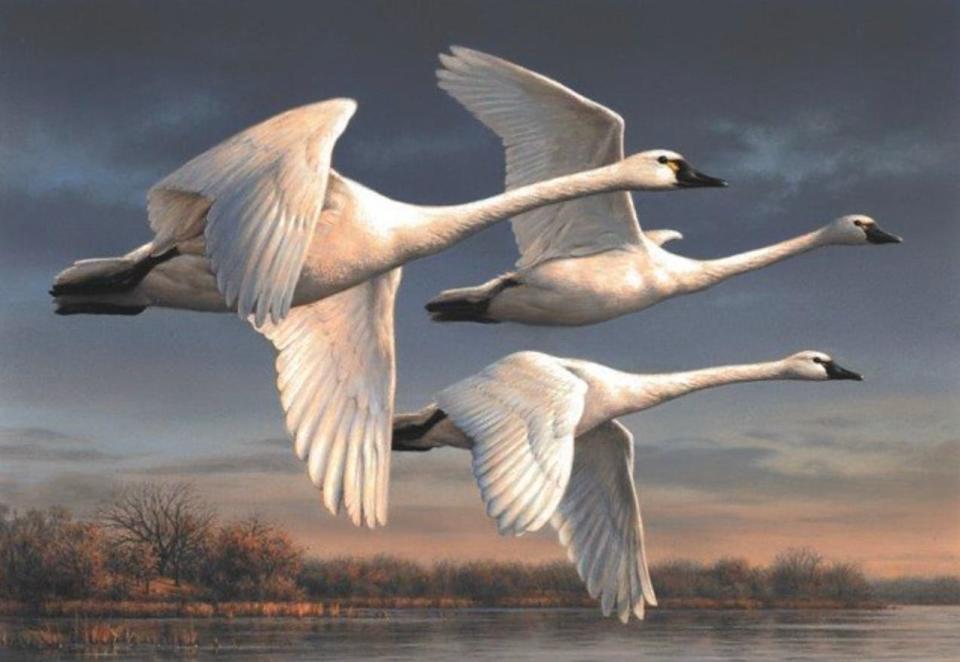Smith: The value of the federal duck stamp to wetlands and wildlife can't be overstated
In case you missed it, the 2023-24 federal duck stamp celebrated its first date of sale on June 23.
The U.S. Fish and Wildlife Service hosted a modest event marking the occasion at the Bass Pro Shops Pyramid store in Memphis, Tennessee.
Don't feel bad if it slipped past you. The annual release of the new edition – officially called the Federal Migratory Bird Hunting And Conservation Stamp – doesn't rank high on fanfare.
But like a football offense that can grind out 4 yards per carry, the duck stamp program makes up for what it lacks in flash with consistent production and success.
In the big leagues of conservation, it's an undisputed champ.
More: Outdoors calendar
The federal duck stamp program has generated about $1.2 billion for wetland conservation
Funds raised through sales of the federal duck stamp – initiated in 1934 – are used to purchase and lease wetland habitat in the National Wildlife Refuge system.
All waterfowl hunters age 16 and above are required to buy the stamp. Many bird watchers and other conservation-minded Americans do, too, as well as some stamp collectors.

Over the last 89 years the stamp has raised about $1.2 billion and conserved about 6 million acres of wetland habitats on national wildlife refuges around the nation, according to the Fish and Wildlife Service.
Those wetlands provide breeding and migratory habitat for millions of ducks and geese each year.
Since hunters must buy it, the stamp qualifies as "user-pay, user-benefit." But it also benefits the general public since the wildlife refuge system is open for a wide range of recreation, including bird watching, kayaking, hiking and fishing.
And the refuges are not only good for waterfowl but hundreds of other species of wildlife, including shorebirds, herons, raptors and songbirds, as well as mammals, fish, native plants, reptiles and amphibians.
So I'd argue it would be more appropriate to characterize the federal duck stamp as "user-pay, everyone-benefit."
Many bird populations have shrunk substantially, but the duck stamp has helped waterfowl thrive
Amid a gloomy picture for birds in general, the value of the stamp to waterfowl has been dramatic. A 2019 paper in Science, a weekly peer-reviewed scientific journal, found the total breeding bird population in the continental U.S. and Canada dropped 29% since 1970, including an estimated 53% loss in grassland bird species, 33% loss in boreal forest species and 17% loss in eastern forest species.
Waterfowl, though, showed a 56% increase over the last five decades, one of the only bright spots in an otherwise dismal decline of avian life.
Authors of the paper credited the relatively rosy status of waterfowl to dedicated programs such as the duck stamp to protect critical habitat for ducks and geese.
A current stamp is also good for free admission to any national wildlife refuge that charges an entry fee.
The memberships of Ducks Unlimited, Delta Waterfowl and other conservation groups are major players in annual purchases of the stamp.
But many other organizations also recognize the value of the duck stamp. The Wisconsin Society for Ornithology, for example, calls the stamp "a huge bargain for conservation."
Sales actually increased after the duck stamp price was raised to $25
On its website the WSO cites the 2015 increase in the price of the stamp – from $15 to the current $25 – and the resulting bump in annual stamp revenue.
"The added $10 per stamp will go into a fund exclusively to acquire easements for land to protect migratory birds," WSO said. "Sportsmen have long been noted for doing more than their fair share, and conservationists should take note."
Annual sales of the stamp bring in about $40 million to the Service, which then decides how much to spend and on what.
In the Badger State, duck stamp funds have purchased 21,136 acres at Horicon National Wildlife Refuge, 11,799 acres at Leopold Wetland Management District, 7,435 acres at St. Croix Wetland Management District, 597 acres at Trempealeau National Wildlife Refuge and 262 acres at Necedah National Wildlife Refuge, according to the Service.
By the way, stamp sales actually increased slightly after the recent $10 (or 67%) price hike. In the decade before the increase, the Service sold an average of 1.51 million stamps per year. Since it went to $25, annual sales have averaged 1.55 million.
The 2023-24 federal duck stamp features the art of Joseph Hautman of Plymouth, Minnesota, winner of the 2022 contest. It features three tundra swans flying over a wetland. It was Hautman's sixth win of the prestigious contest.
How does someone buy a duck stamp?
Although it might not have made your social feed or the nightly TV news, this year's first date of sale event represented a return to pre-COVID practices.
"It’s so very exciting to be with our partners again, in-person, at a special event for one of the most revered conservation programs in the entire country,” Jerome Ford, assistant director for the Fish and Wildlife Service's migratory bird program, said in a statement. “I am so honored to be one of the first people to buy my federal and junior duck stamps and encourage others to join me as we all collectively contribute to the conservation of wetlands across the country.”
If you don't normally buy one, I encourage you to start an annual tradition and make an investment in wetlands and wildlife and purchase a 2023-24 federal duck stamp. They are available online at duckstamp.com and in-person at many U.S. post offices.
And if you are a regular buyer, on behalf of the ducks and more, thank you.
The 2023 federal duck stamp art contest to select the 2024-25 stamp will be held Sept. 15 and 16 in Des Moines, Iowa.
This article originally appeared on Milwaukee Journal Sentinel: Federal duck stamp sales protect wetlands and benefit wildlife

